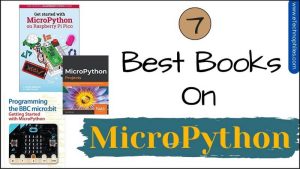Last updated on March 28th, 2024 at 01:08 pm
Are you someone who is looking to learn the trendy language – MicroPython? If yes, then you just clicked on the right link. This article has a list of books you can use to learn and implement MicroPython.
This is not just any list, our research team has put in lots of effort and thought to come up with a list of only the best books on MicroPython.
List of 7 Best Books on Mircopython
MicroPython and the Internet of Things by Miguel Grinberg
Learn to program digital circuits using Python and MicroPython with the help of Miguel Grinberg. All the programs covered in this book are based on the ESP8266 chip. You will find that the author prefers a plug-and-play option instead of soldering the hardware components together.
You will learn to program sensors and screens to achieve the desired end product. Grab your best self and dive right into the programming world of MicroPython with this book.
Pros:
- The project covered in the book is quite cost-effective.
Cons:
- Even though the book is for beginners it doesn’t cover the extreme basics of MicroPython language. You need to have some form of prior understanding of this programming language to start the book.
Programming the BBC micro: bit by Simon Monk
This book is an excellent guide for getting started with MicroPython. It starts with the very basics and slowly takes you to advanced concepts. At the end of this book, you can successfully build a simple IoT project with minimum hardware.
You will first learn to write programs with MicroPython then you will learn to connect different hardware parts by programming them to work as a single unit. You will be using the micro: bit throughout the book.
Pros:
- You need not have any prior knowledge of MicroPython to get started with this book.
Cons:
- The book solemnly focuses on the micro: bit and no reference to any other board has been provided.
Get started with MicroPython on Raspberry Pi Pico by Gareth Halfacree and Ben Everard
If you are looking for a beginner-friendly book on Raspberry Pi Pico then look no more because we found this perfect book for you. You will be using the latest Raspberry Pi Pico board to program with MicroPython.
You can program the pins to collect data from other components and use them to manipulate the things around you. Explore this colorful book and get things running around you.
Pros:
- The book contains amazing illustrations which are quite attractive and the book more interesting and appealing.
Cons:
- Several readers have found the contents of the book quite superficial.
Python for Microcontrollers by Donald Norris
Looking for a DIY guide on microcontrollers? This is it. This book will teach you to program Pyboard, ESP8266, and WiPy using MicroPython – a beginner-friendly programming language. The book will teach you to design and program a let ball detector using the 3-axis accelerometer. You can build several such interesting projects once you are done with the book.
Pros:
- The book covers information about 3 major MicroPython hardware platforms.
Cons:
- The book alone is not sufficient for beginners. You will need to take a lot of online help to elaborate on certain concepts that the author decides should not be explained further.
Programming with MicroPython by Nicholas H. Tollervey
Looking for a book that tells you how to program different boards with MicroPython? Your search ends here. This book works with PyBoard, the micro: bit, Adafruit’s Circuit Playground Express, ESP8266, and ESP32 boards.
You will learn multiple practical applications of MicroPython such as visual feedback, input and sensing, GPIO, networking, sound and music, and robotics.
Pros:
- This book lets you explore a framework that can help you generate, evaluate, and evolve real-world embedded projects.
Cons:
- This book will be terrifying for beginners if you do not know how to write and run a program in Python.
MicroPython Projects by Jacob Beningo
This book is a DIY guide for embedded developers to build a variety of applications using Python. You will learn to develop embedded systems in minimum time and at a low cost. Throughout the 10 chapters of the book concepts like managing real-time tasks, writing a MicroPython driver, developing an application test harness, customizing the Kernel start-up code, custom debugging, device control with gestures, etc. are covered.
Pros:
- The chapter on RTOS is quite comprehensive and is loved by many advanced readers.
Cons:
- This is not a generalized book, it is intended for a specific set of audiences who have previous experience in building embedded systems.
MicroPython for the Internet of Things by Charles Bell
If you want to program microcontrollers with MicroPython then this is a very good book to start. You will learn faster and easier ways of programming. You will be able to load MicroPython on ESP8266 and other boards with ease. This book will make the creation of IoT projects easier with the help of MicroPython.
Pros:
- Examples based on the WiPy and LoPy4 boards are very well explained in the book.
Cons:
- The book has not been updated to meet the latest standards.
Conclusion – Best Books on Micro Python
Learning MicroPython is made easy with this list. If you ask us to pick the top best from this list then we would pick Programming with MicroPython by Nicholas H. Tollervey. This book is everything you will need to start your MicroPython journey.
If you think we left out any important book on MicroPython then let us in the comments section.














